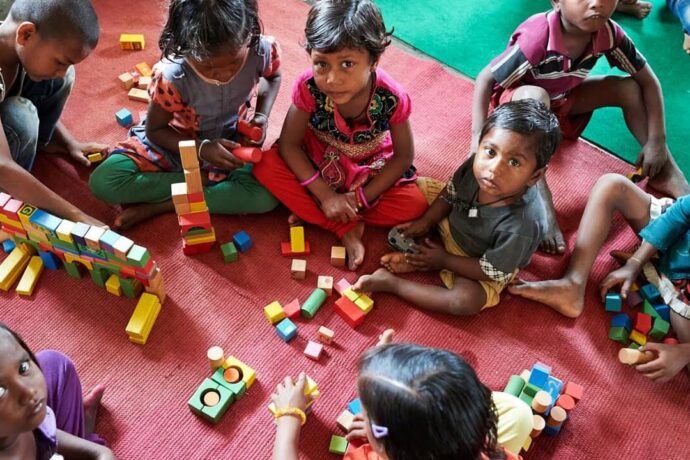Policies in India to support Early years and Education.
Recognising the importance of the early years (ECD), Target 4.2 of the Sustainable development Goals states that by 2030 countries should: ‘ensure that all girls and boys have access to quality early childhood development, care and pre-primary education so that they are ready for primary education’. However, SDG commitments to ECD are much broader than this education focused target.
India has the world’s largest ECD programme, the Integrated Childhood Development Services scheme (ICDS), that has the potential to deliver high quality child health and developmental services. It provides the critical frame of reference for most non-governmental organisation (NGO) activity. The chalk horse of these services is the Anganwadi Centers (AWCs) where an entire array of early childhood services is provided, focussing largely on supplemental nutrition, immunization, and other basic health and early preschool education needs. The Ministry of Women and Child Development (MWCD) is responsible for the policy on ECCE and is in charge of delivering the pre-school component of ICDS Scheme to its beneficiaries.
The reality however, in the urban slums of India, where very few of these AWCs operate, child health and developmental services are mainly delivered by NGOs and other Voluntary organisations. In addition to this there is a huge disparity between the level of attainment between the advantaged and disadvantaged children. So, the question is, where is the gap and why despite the various policies Early years is not the primary focus in India?
Where is the Gap?
It has been unanimously agreed that the Early Years is the most important stage of development of the human brain. A large body of worldwide research demonstrates that exposure to enabling environments and access to appropriate inputs during this period contributes significantly to the Long-term growth and learning.
The National Education Policy 2020 has emphasized the importance of parents as carers in providing the child with a stimulating learning environment, and that the first two-and-a-half to three years need not be in a structured learning environment. Although the policy recognises the value of including parents, family and society, and seeks to help Early-Years Practitioners, Service Providers, ECCE teachers etc in providing children with rich early stimulation and learning opportunities from birth to pre-primary, there is a big gap between the advantaged and the disadvantaged children.
In a blog post written by the Deputy Chairman and Chief Operating Officer at KPMG, Scott Ozanus, writes that research has shown that learning gap between the advantaged and disadvantaged children can show up as early as nine months of age.
The gap then perhaps lies in the fact that we are not investing enough in the key players in the child’s formative years, that is, the main carers/parents.
What does ASER report say?
The quality of provision of Early Childhood development services continue to remain a concern, and little evidence is available to ascertain whether young children are being supported in this phase of their lives. Furthermore, it is not always clear what parents, families and community members might do to help young children cope with the demands of academic learning and everyday life. It is also agreed by Child Development experts that exposing young children to academic learning too early is counterproductive; but many other adults responsible for children’s welfare – parents and policy makers alike – do not.
The ASER data from 2018 shows that across rural India, 10% children age 4 and 34% children age 5 are already attending primary school. Similar findings have been reported in the India Early Childhood Education Impact (IECEI) study, 2017.
ASER data also indicates that even in the early primary grades, large proportions of children do not have the reading and numeracy skills required to keep up with the expectations of their grade level textbooks. Lack of access to an appropriate environment in the early years means that many children do not have the skills and abilities expected of them when they enter school, which therefore makes it difficult for them to cope with the school curriculum. Once they fall behind, it is difficult to catch up.
The draft National Education Policy 2019 acknowledges, “A major part of this (learning) crisis appears to be occurring well before children even enter Grade 1”. Due to a lack of any suitable pre-primary options and limited (ECCE); mostly the disadvantaged children often remain the most behind in primary school and beyond.
What the way forward should look like in early years?
The world’s poorest children are often exposed to cumulative risks with associated increase in adverse effects. The evidence that early intervention can stop the loss in developmental potential is strong. Research suggests that what children experience during the early years (prenatal to the age of 5 years) creates a trajectory across the lifespan. Adverse exposures and experiences in early childhood causes early deficits that are compounded and become increasingly difficult to reverse beyond early childhood. This includes increased risk of poor social, cognitive, and health outcomes, including economic dependency, violence, crime, substance misuse, and adult onset of non-communicable diseases.
Due to its complex and multidimensional nature, Early Childhood development requires a range of professionals from various sectors to collaborate so that support for each child’s learning and developmental needs are addressed in an integrated and holistic way.
Partnership plays a key role in bringing together different philosophies and professional backgrounds, to provide a more comprehensive service, to meet the diverse learning and developmental needs of the children.
What should non-profits, government and other stakeholders do?
In order to achieve the best outcome for children and to help them thrive, support needs to be provided at an early stage before a problem becomes irreversible.
The following steps can help in addressing the gap in Early years provision:
Advocacy- The needs and abilities of children in the early Years needs to move into the centre of the current debates on educational policies in India and understood by a much wider set of actors – parents and community members as well as policy makers and early childhood development professionals.
Positive Parenting- Immediate action needs to be put in place to build awareness amongst primary care givers regarding the stages of development in children and how they can best provide the care and stimulation required for children in the early years of their lives. This means protecting the vulnerable children from neglect and abuse and supporting parents to meet the needs of the children.
Statutory framework- A set of standards needs to be introduced for Early Years, which all early year’s providers must meet to make sure children are given the most favourable opportunity to learn and develop and are kept healthy and safe.
Building stronger communities: To be able to meet the needs of the children, there needs to be a robust network of key players working in child development sector, including partnerships with families, schools, health, police, voluntary sector organisations and government.
What challenges might occur?
According to an article written by Save the Children, Early Childhood development is often perceived as a luxury that is only accessible and applicable to the more economically affluent, rather than the poor. In developing countries, especially amongst the disadvantaged who are struggling to ensure they are able to meet their basic needs, early childhood development is commonly neglected and investing in Early years can appear to be extravagant, and even superfluous.
Conclusion
The consequence of such severe deficit in investing in early Childhood can have a permanent, damaging impact on children’s long-term development. In short, Early Childhood development should be at the forefront of the government agenda. Actors in the public, private and voluntary sectors should make a measurable contribution to ensure that all children- including the most marginalised and disadvantaged- have access to services which support their physical growth and overall development; and parents are included as key players in the overall development and well-being of the children.


